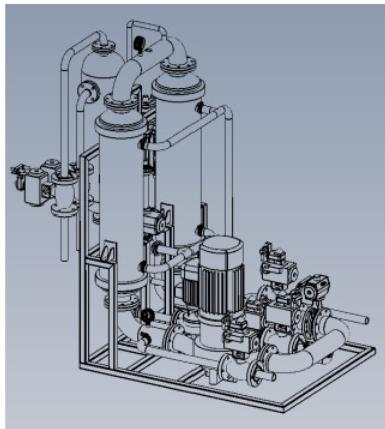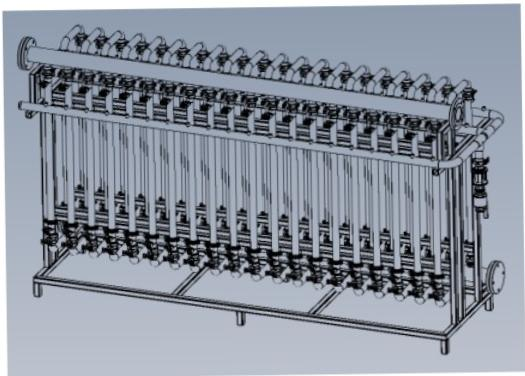18072885002
Application of silicon carbide ceramic membrane in silica sol concentration
Introduction
In the membrane separation industry, materials drive the updating and iteration of membrane separation products and the development of application technologies.
Silicon carbide is a recognized next-generation ceramic membrane separation material in the industry, with significant performance advantages such as high throughput, corrosion resistance, easy cleaning, long service life, and excellent oil-water separation.
Advantages of silicon carbide ceramic membrane:
High throughput, corrosion resistance, easy to clean, and long service life
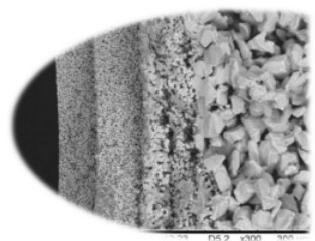
Filtration principle
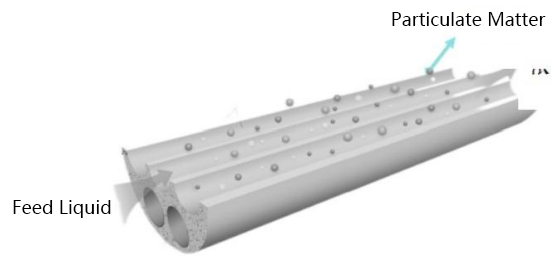
The silicon carbide ceramic membrane ultrafiltration device is driven by positive pressure and achieves solid-liquid separation within an optional range of 0.2-0.6 bar transmembrane pressure difference.
Silicon carbide ultrafiltration has the following advantages:
1. Ideal filtration accuracy, suitable for concentration of silica sol products with different particle sizes, 830, 1430 or larger particle sizes;
2. The processing scale can be large or small, continuous or intermittent, and the membrane components can be used alone or in combination. The process is simple, the operation is simple, and it is easy to automate control.
3. Stable and long-lasting filtration performance and reliable service life, with a 3-year warranty and a service life of over 5 years.
Application of silicon carbide ceramic membrane in silica sol
As an important inorganic polymer material, silica sol has been widely used in fields such as chemical industry, precision casting, textile, paper-making, coatings, food, electronics, and mineral processing.
At present, the production process of silica sol in China mainly adopts a dilute silica sol with a concentration generally between 2-5% after ion exchange and stabilization of sodium silicate. This solution needs to be concentrated to over 30%, and the concentration factor of the gel solution is relatively large. Most of them use ultrafiltration concentration. JMFILTEC has developed two types of silicon carbide tubular membrane ultrafiltration filters based on the operational requirements of different silica sol production enterprises.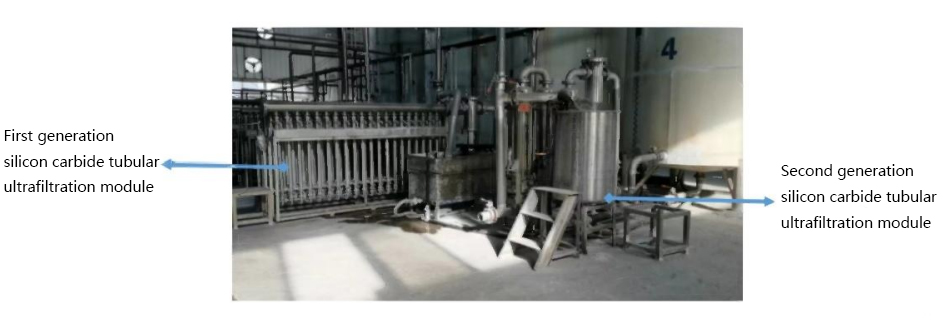
Multi-core series first generation silicon carbide tubular membrane ultrafilter
Main equipment configuration
| Name | Parameter |
| Membrane Container | 19 core packaging, single-set membrane container is used to fill 19 silicon carbide tubular membrane element of model JMfiltec-SICT-40-H-19-1200-DZ. |
| Membrane Element | The model is JMfiltec-SICT-40-H-19-1200 -DZ, single filter area is 0.5 square meters |
| Circulating Pump | Q≥140m3/hr, H=28m, N=18.5Kw |
| Land Occupation Area | Length × Width=1500 x 500mm |
| Quantity | Notes |
| 3 sets | Membrane container material 304 or 316L |
| 57 pieces | The total installed membrane area is 28.5 square meters, with a working capacity is 6-8 m/h (through liquid) |
| 1 unit | |
| Filtration host area (excluding pump and cleaning water tank) |
The characteristics of the first generation silicon carbide ultrafiltration device:
1. The working capacity of a single silicon carbide ultrafiltration device is 1.5-2 times that of traditional PVDF organic tubular membrane ultrafiltration devices;
2. The footprint is one-quarter of that of traditional PVDF organic tubular membrane ultrafiltration filters;
3. Silicon carbide ultrafiltration has almost no replacement cost for membrane components;
4. Operation does not require consideration of cooling, and can adapt to working environments ranging from 60 ℃ to 120 ℃.
Single core parallel connection first generation silicon carbide tubular membrane ultrafiltration
Main equipment configuration
| Name | Parameter |
| Membrane Container | Single-core packaging, single-set membrane container is used to fill 1 silicon carbide tubular membrane element of model JMfiltec-SICT-40-H-19-1200-DZ. The seal is made of single-cone FKM material |
| Membrane Element | The model is JMfiltec-SICT-40-H-19-1200 -DZ, single filter area is 0.5 square meters |
| Circulating Pump | Q≥140m3/hr, H=28m, N=18.5Kw |
| Land Occupation Area | Length × width × height=3100 × 1100 × 1600mm |
| Quantity | Notes |
| 60 sets | Membrane container material 304 or 316L |
| 60 pieces | The total installed membrane area is 30 square meters, and the working capacity is 6~8m³/h (permeate liquid) |
| 1 set | |
| Filtration host area (excluding pump and cleaning water tank) |
Characteristics of second-generation silicon carbide ultrafiltration:
1. The working capacity of a single silicon carbide ultrafiltration device is 1.5-2 times that of traditional PVDF organic tubular membrane ultrafiltration devices;
2. The footprint is two-thirds of that of traditional PVDF organic tubular membrane ultrafiltration filters;
3. Silicon carbide ultrafiltration has almost no replacement cost for membrane components;
4. Compared to the first generation of silicon carbide ultrafiltration, single membrane components are easy to replace after damage; The first generation of silicon carbide ultrafiltration requires dismantling a 19 core membrane container for the inspection of damaged membrane components, which is a complicated process.
5. Operation does not require consideration of cooling, and can adapt to working environments ranging from 60 ℃ to 120 ℃.
The causes of membrane contamination
Low flow rate of feed liquid
Generally, the flow rate on the ultrafiltration membrane surface is easily controlled at 2.5-3 m/s. At low flow rate, a gel layer will be attached to the ultrafiltration membrane surface, and the penetration rate will decrease rapidly.
Incomplete replacement during ultrafiltration shutdown
When shutting down, it is necessary to push out the silica sol inside the membrane module and perform protection or chemical cleaning. If not completely replaced in time, the silica sol will deposit on the membrane surface, forming a layer of adhesive membrane, which affects the transmission speed.
The impact of the material liquid itself
Incomplete reaction and poor colloidal stability can easily contaminate the ultrafiltration membranes.
Membrane fouling countermeasure
The necessity of cleaning:
After operated for a while, ultrafiltration membranes often experience membrane blockage and concentration polarization. Membrane blockage is caused by the deposition of certain components on the membrane surface and within the pores, resulting in pore size changing. The concentration polarization phenomenon refers to the concentration gradient formed on the membrane surface by intercepting components in the opposite direction of filtration. These two phenomena coexist during the concentration process of silica sol, leading to a significant decrease in the filtration capacity of the membrane. To ensure high permeability of the membrane (i.e., the capacity of solvent transfer per unit surface area) and significant retention rate (i.e., the membrane has the ability to retain solutes above a fixed molecular weight), the ultrafiltration system operates for one cycle (usually concentrating one tank of material) and undergoes a protective cleaning with permeated water. After a certain period of operation or when the inlet flow rate is below the parameter range, chemical cleaning must be carried out in a timely manner.
Effect of cleaning:
Remove components deposited in the membrane pores that affect membrane permeability; Remove low molecular weight salt substances from the membrane pores; Failure to form silica sol with sufficient particle size; Remove product particles deposited inside the ultrafiltration membrane tube; Disinfect the pipeline to control bacterial growth and reproduction; Clean pipeline valves, pumps, and other parts.
Cleaning method:
After each concentrated batch, rinse the membrane with protective water for 15 minutes; After operating for 50 hours, perform chemical cleaning (usually using 5% NaOH aqueous solution as cleaning agent), intermittent production requires daily cleaning. The cleaning agent can be reused multiple times.
Prevention of membrane contamination
1. Pay attention to the flow rate of the circulation pump and ensure that the pressure meets the needs of the ultrafiltration device;
2. When the membrane is not used for a long time, pay attention to anti-corrosion and water sealing;
3. Establish a file of ultrafiltration operation
4. Equipped with a precision filtration system and regularly cleaning filter bags;
5. Ensure that the silica sol passing through the ultrafiltration device has normal pressure drop and membrane surface flow rate;
7. When shutting down the machine for a period of time, it should be cleaned and water sealed in a timely manner to ensure that the membrane surface is moist.






